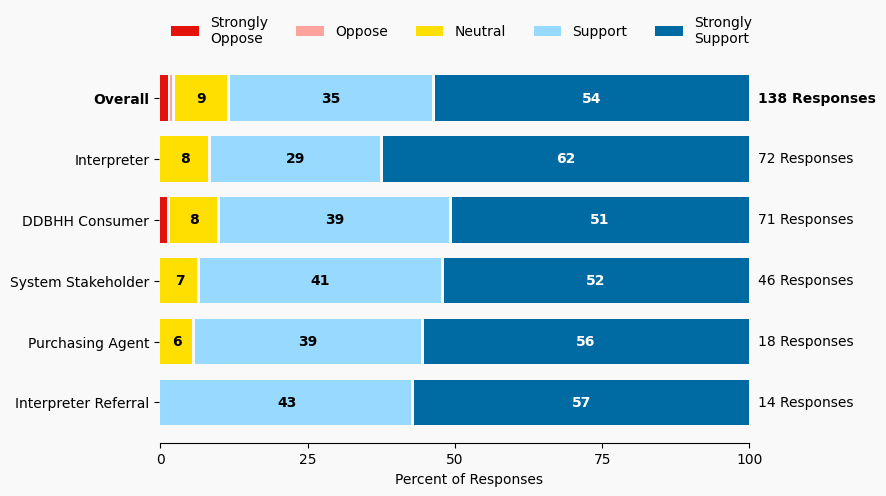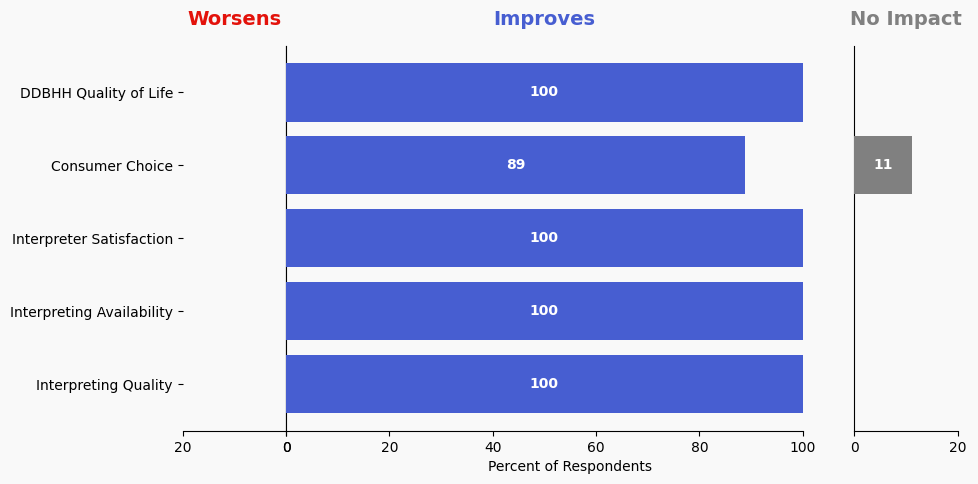25 Invest in CDI Professional Development
Issue: Deaf interpreters in Minnesota have great potential as a sustainable profession. With a larger DeafBlind population, there is more demand for Deaf interpreters to work with DeafBlind people in all settings. Recent trends indicate that CDIs will continue to be used for press conferences. Further, state legislation passed that allows for CDIs in the classroom and for the expense of a CDI to be reimbursable from the state. In addition to immigrant populations and the need for CDIs in court and legal settings, there are more settings where CDIs can benefit DDBHH consumers and hearing team interpreters. With this, continued investment in CDIs’ professional development is necessary.
Proposed Solution: Interpreter referral companies invest in training for Deaf interpreters. (See #26 re CDIs as staff interpreters.) Both KIS and ASLIS have CDIs on staff. More funding to hire more CDIs on staff and utilize more CDIs in different settings while leveraging other CDI skill sets would benefit a larger pool of Deaf and hearing interpreters.
Expected outcome: Immediate increased availability and quality of interpreting services. More Deaf interpreters are employed and influencing the next generation of Certified Hearing Interpreters (CHIs). DDBHH consumers gain more exposure to Deaf interpreters.
Who is impacted: Deaf interpreters, hearing team interpreters
Timeline: 6 months

Summary of Support Image Description
The stacked bar charts show how respondents rated their level of support and the total number of responses. The percentage for the five support levels is shown from left to right: Strongly Oppose (Dark Red), Oppose (Light Red), Neutral (Yellow), Support (Light Blue), and Strongly Support (Dark Blue).
Respondents may identify with multiple subgroups. The overall level of support is:
Overall
Strongly Oppose: 1%
Oppose: 1%
Neutral: 9%
Support: 35%
Strongly Support: 54%
Click to see the detailed image description for each subgroup.
Interpreter
Strongly Oppose: 0%
Oppose: 0%
Neutral: 8%
Support: 28%
Strongly Support: 62%
Interpreter Referral
Strongly Oppose: 0%
Oppose: 0%
Neutral: 0%
Support: 43%
Strongly Support: 56%
DDBHH Consumer
Strongly Oppose: 1%
Oppose: 0%
Neutral: 8%
Support: 39%
Strongly Support: 51%
Purchasing Agent
Strongly Oppose: 0%
Oppose: 0%
Neutral: 6%
Support: 39%
Strongly Support: 56%
System Stakeholder
Strongly Oppose: 0%
Oppose: 0%
Neutral: 7%
Support: 41%
Strongly Support: 52%
Overview of Respondents Opting for In-Depth Solution Analysis
After indicating their support level, 6% of the 138 respondents opted in to further assess whether the solution would worsen or improve on five metrics. Of the opt-in reviewers (9 respondents), 100% supported the solution, 0% were neutral on the solution, and 0% opposed the solution.
The remaining 129 respondents did not opt in to further assess the solution. Of these people, 87% support the solution, 10% were neutral on the solution, and 2% opposed the solution.
Reviewer Evaluation of Solution Effectiveness

Solution Effectiveness Image Description
The stacked bar charts show how respondents assessed the effectiveness of this solution based on five metrics. For each metric, the percentage of respondents is shown from left to right: Worsens (Red), Improves (Blue), No Impact (Gray).
DDBHH Quality of Life
Makes It Worse 0%
Makes It Better 100%
No Impact 0%
Interpreter Satisfaction
Makes It Worse 0%
Makes It Better 100%
No Impact 0%
Consumer Choice
Makes It Worse 0%
Makes It Better 88%
No Impact 11%
Interpreting Availability
Makes It Worse 0%
Makes It Better 100%
No Impact 0%
Interpreting Quality
Makes It Worse 0%
Makes It Better 100%
No Impact 0%
Reviewer Feedback and Insights
Interpreter
Comments from Interpreters express strong support for more training and development for CDIs, with specific mention of teaming between CDIs and hearing interpreters. Concerns highlight the lack of current training opportunities and the need for practical training environments. Suggestions include exploring partnerships with institutions like Metro State University to offer more educational programs for Deaf interpreters.
Deaf, DeafBlind, Hard of Hearing
Comments from DDBHH Consumers suggest that many interpreters are working for multiple companies and question how this will benefit them. Comment emphasizes the need for more CDIs and raises concerns about the role of for-profit agencies in interpreter referrals. One comment suggests exploring nonprofit models to better support the interpreting profession.
System Stakeholder
Comments from System stakeholders echo the need for more CDIs and suggest that post-secondary institutions could play a role in providing training for Deaf interpreters. One comment expresses concern around the lack of accessible training and the role of nonprofits in reducing markup costs in interpreter services.
PREVIOUS SOLUTION
24 Host DDBHH & Interpreter Meet-and-Greet
Issue: Concerns have been raised about divisiveness in the interpreting and DDBHH communities. Interpreters and DDBHH community members do not have many opportunities to come together with a focus on getting to know each other to be better prepared to work together in different settings.
NEXT SOLUTION
26 Mentor Programs Focus on CDIs Mentoring Hearing Interpreters
Issue: Hearing interpreters report needing more mentoring to advance their skills. Often ASL fluency is a challenge for newer interpreters.
Leave a Reply